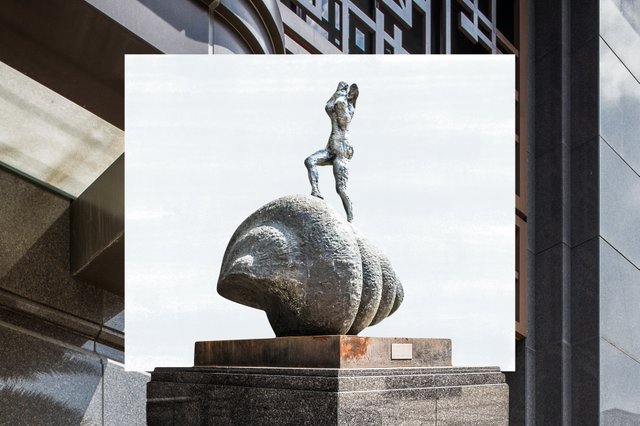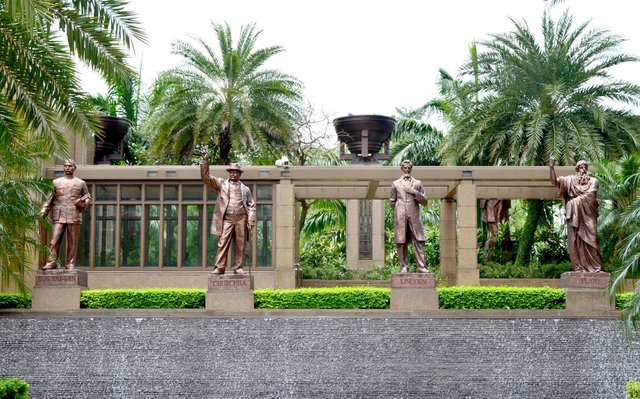
A good thing about getting lost is you find the unexpected. This was our luck on our first morning in Singapore. We had studied the map to know we could walk out of our luxurious quiet hotel and down town to the Hop on Hop off bus depot. We looked forward to the walk after the long flight the day before and seeing Singapore. We did not expect the chaos, the heat, the rush and bustle , the noise, the complicated roads, the building sites and hence were quickly lost. That’s when I heard a fountain playing and noticed a calm square between towering building and curiosiously we decided to investigate.

Nude Woman ascending Staircase
We discovered a haven of sculptures . Workers whisked past gobbled up by the buildings, locals hurried by heads down about their business. We, like the pilgrims we wanted to be rather than tourist, we looked, stopped and enjoyed the experience. That is when Nude Woman Ascending the Staircase caught my attention. I loved the paradox of softness (the animal and hardness (the shell ) and the sculpure of the soft body of the female figure climbing
and the message of portraying helplessness by her body being headless was powerful for me.
It just blew my mind. I would like to say she climbed into a ceilingless sky
but a canopy of unbroken glass was part of the building was obviously in the way.
There were quite a few other installations and scuptures set up by the owner of the Park View Square set up as a tribute to elegance and humanity Parkview Group was established by the Hwang family, Several embassies are on different floors and the Ground floor is a very popular baar which we did not get to see



Parkview Square is located in Bugis area. Singaporeans have dubbed it the “Gotham Building” because its dark, imposing design looks like it’s been conceived in Batman’s Gotham City.
I first visited this place a few years ago for drinks at the lobby bar. What intrigued me the most, is the fact that this building seemed rather out of place. It’s so sombre and opulent that I thought it only belonged in another era, a difference country. Looking around, you could feel the total devotion, an enormous sense of pride and perhaps even some self-indulgence (i say this with the utmost respect and envy) of its architects and designers, under a no-expense-is-spared commission of their visionary client, the late Mr. C. S. Hwang, founder and chairman of Chyau Fwu Group.
(Image source: parkviewsquare.com.)
Unlike many contemporary office buildings that emphasize the application of steel and glass in minimalistic fashion, Parkview Square (Year 2002) was built in the classic Art Deco* style, similar to the Chanin Building (Year 1929) in New York. The facade of this building is mostly clad in brown granite, bronze and lacquer.
(* Art Deco is a style of visual arts, architecture and design that first appeared in France just before World War I. It combined modernist styles with fine craftsmanship and rich materials. Influenced by bold geometric forms and bright colors of the art movement then, it often draws inspiration from the exotic art of ancient China, Japan, India, Persia, Egypt and Maya.)
The night view. Image source: Meinhardt Singapore.
(Image source: Steve Taylor, flickr.com)
There are many statues and sculptures both outside and inside the building, here I will only highlight the more prominent ones. Let’s start from the top (shown in the above photo.) Actually, there is a story/urban myth behind these statues sitting atop the building which can hardly be seen from the ground level. If you take a look at the first photo in this post again, you will notice there are 2 diamond-shape buildings behind Parkview Square, which are The Gateway (Year 1990) designed by the world renowned architect I.M. Pei. (I’m a huge I.M. Pei fan, too. He just turned 100yr old this April!) However, many local Feng Shui masters speculate that the design of The Gateway is considered “bad luck” for any other buildings to be near it, because of its dagger-like appearance. People believe that it would “cut through” all the other buildings, and the tenant companies in their building will be doomed to fail (“cut to pieces”.)
So for many years, the area around The Gateway remained undeveloped. That is, until 2002.
In 2002, Park View Square was built, and it was specially designed in the classic Art Deco style to protect itself from the “daggers” of Gateway. The 8 gigantic statues of men holding a light ball in their hands, 4 of them standing on each broad side of the building’s crown, were crafted to “guard” Parkview Square against “bad luck.” Believe it or not, this story does show you that it’s not uncommon among Chinese property developers to consult their trusted Feng Shui masters before committing to a project.
This photo is taken by me, so is the next one.
Now we have come to the ground level. Standing in the center of the plaza, facing the main building, you could see there is a statue of a golden crane with its head lifted, pointing towards the direction of mainland China. On the pedestal, a Chinese poem is written:
黄鹤楼 Yellow Crane Tower (Referring to Parkview Square)
故国旧有黄鹤楼 There is a Yellow Crane Tower in my homeland,
北望神州几千秋 Looking in the North direction (towards China) for many years,
黄鹤展翅飞万里 Yellow Crane spreads its wings to fly tens of thousands of miles,
伟哉狮城见鹤楼 The great Lion City (Singapore) sees this Yellow Crane Tower.Pardon my plain and literal translation of this poem. It was composed by the late Mr. C. S. Hwang himself. This is the most personal and meaningful art piece at Parkview Square because of Mr. Hwang’s life experience. He was born in Teochew, China in 1926. During the Second Sino-Japanese War (1937-1945) he joined the Kuomintang/Nationalist Party (as opposed to the Communist Party) army as a reporter. After the Japanese surrendered in 1945, and the Communist Party won the Chinese Civil War in 1949, he retreated to Taiwan along with the Kuomintang army. While in Taiwan, Mr. Hwang started a construction business that became very successful, and he had since established himself as an influential property developer in Taiwan, Hong Kong, mainland China, France and Singapore. His company earned a reputation for top-end landmark projects that set new benchmarks for quality and innovation.
For someone who traveled extensively and lived in different countries, Mr. Hwang always had a longing for his hometown in China. This poem expresses his feelings deeply. Parkview Square was his final project, as he passed away 2 years later in 2004.
(Image source: Andrew Boyd, flickr.com) These are the bronze statues on both sides of the plaza. From left to right: Sun Yat-sen, Churchill, Lincoln, Plato. There are another 4 which are not shown here, they are Dante, Dali, Newton, and Chopin.
Mr. Hwang (and his eldest son George Wong’s) love for Dali’s art is quite evident as there are 2 sculptures by the Surrealist artist installed in the garden, and another 4 in the lobby. They’re part of George Wong’s personal collection. I like Dali’s paintings much more than his sculptures, to be honest. Because they are way more imaginative, expressive and magical.
Snail Queen (1974), by Salvador Dali. Bronze, 180 x 290 x 87cm. (Image: tsingapore.com ) I quite like how they digitally added a giant canvas behind to showcase each piece, eliminating background distraction.
Naked Woman Climbing A Staircase (1974) by Salvador Dali. (Image: tsingapore.com )
There is also a sculpture by Fernando Botero, Dressed Woman. (Image: Choo Yut Shing, flickr.com) It’s always pleasant to look at Botero’s distinctive voluptuous sculptures because in reality most people are attracted to slim bodies. There is another sculpture by Botero (titled Bird) in Singapore as public art, it’s installed outside UOB building along Boat Quay.
Ok, it’s time to go inside for a drink now!
(Image source: atlasbar.sg) The lobby is majestic! However, it’s never this bright. Even in daytime, it’s still pretty dark and chill indoor. Excellent ambiance! Very cozy and relaxing.
The newly renovated Atlas Bar is known for its very special champagne and gin collection, and it’s helmed by one of Europe’s leading bartenders, Roman Foltan, who previously worked at Artesian at The Langham, which is voted the World’s Best Bar four times consecutively.
My friends and I had enjoyed the cocktails very much, even though i usually prefer plain alcohol served as it is, or maybe just add water/ice.


 The night view. Image source: Meinhardt Singapore.
The night view. Image source: Meinhardt Singapore. (Image source: Andrew Boyd,
(Image source: Andrew Boyd,  (Image source:
(Image source: